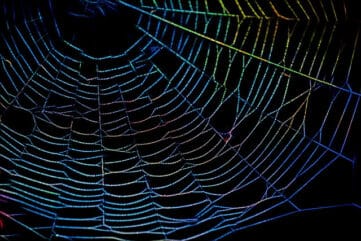The crowned orb weavers keep the entomologist awake, the hair follicles of his ears attach to the sound of spinnerets between the hours of two and five a.m. He thinks, silk, the chosen fabric of the wealthy, is a death shroud for the unfortunate.
That night, he dreams he is a spider, with long mottled legs. His teeth secrete enzymes that liquefy the innards of his prey.
In the morning, he propositions his pharmacologist friend to alter their diurnal habits. So the pharmacologist drugs flies and feeds them to the weavers, their caffeinated webs resemble the shattered glass of broken windows.
Beneath rain clouds the spiders swallow their silk, spin when the rains cease. The entomologist’s daughter chews her hair, compelled by her time spent as a spider. She goes unnoticed.
The entomologist feeds the weavers black flies full of LSD and superior fractal patterns emerge in what appears to be three-dimensional tunnels, their eight eyes and eight legs compose death web symphonies.
The weaver’s circadian rhythm remains the same. So the scientists try cannabis and speed, but their sleeping habits don’t change.
In a sunlit room, the entomologist’s daughter asks her friend about her life as a moth with soft white wings, and why she fears transparent things.
The weavers go on spinning, consuming and killing. The entomologist invests in earplugs, as the spiders build their webs between leaves and fading moonlight.
–
Gabrielle Griffis is a mutlimedia artist, writer, and musician. She studied creative writing at the University of Massachusetts Amherst, where she also worked for the Juniper Writing Institute. She is the Outreach Coordinator for Wellfleet Public Library. Listen to her music here.
Lead image: “The spider web” (via Flickr user bluesbby)

